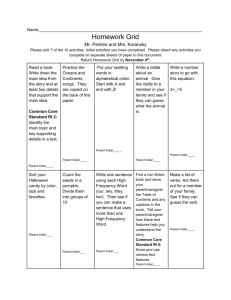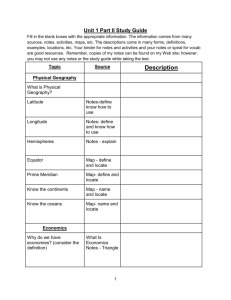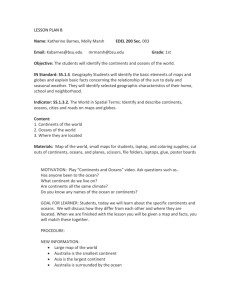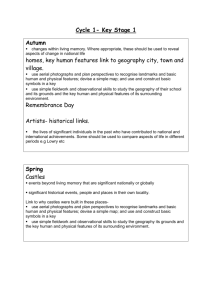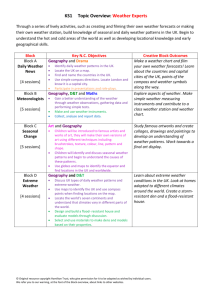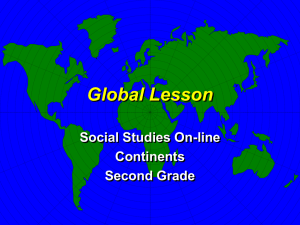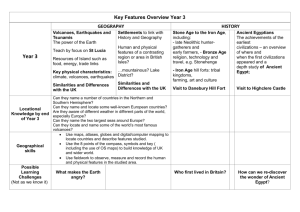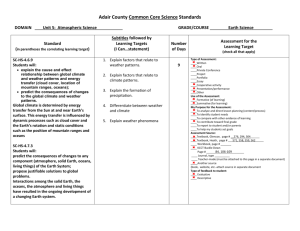Geography
advertisement
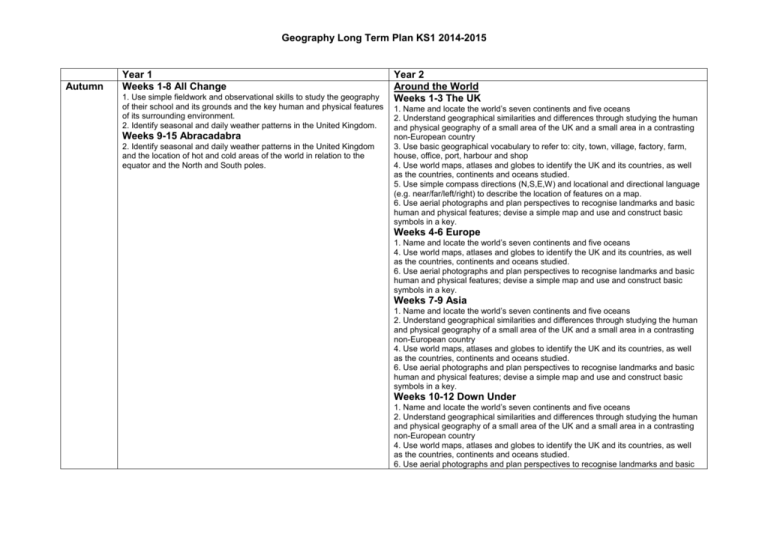
Geography Long Term Plan KS1 2014-2015 Autumn Year 1 Weeks 1-8 All Change 1. Use simple fieldwork and observational skills to study the geography of their school and its grounds and the key human and physical features of its surrounding environment. 2. Identify seasonal and daily weather patterns in the United Kingdom. Weeks 9-15 Abracadabra 2. Identify seasonal and daily weather patterns in the United Kingdom and the location of hot and cold areas of the world in relation to the equator and the North and South poles. Year 2 Around the World Weeks 1-3 The UK 1. Name and locate the world’s seven continents and five oceans 2. Understand geographical similarities and differences through studying the human and physical geography of a small area of the UK and a small area in a contrasting non-European country 3. Use basic geographical vocabulary to refer to: city, town, village, factory, farm, house, office, port, harbour and shop 4. Use world maps, atlases and globes to identify the UK and its countries, as well as the countries, continents and oceans studied. 5. Use simple compass directions (N,S,E,W) and locational and directional language (e.g. near/far/left/right) to describe the location of features on a map. 6. Use aerial photographs and plan perspectives to recognise landmarks and basic human and physical features; devise a simple map and use and construct basic symbols in a key. Weeks 4-6 Europe 1. Name and locate the world’s seven continents and five oceans 4. Use world maps, atlases and globes to identify the UK and its countries, as well as the countries, continents and oceans studied. 6. Use aerial photographs and plan perspectives to recognise landmarks and basic human and physical features; devise a simple map and use and construct basic symbols in a key. Weeks 7-9 Asia 1. Name and locate the world’s seven continents and five oceans 2. Understand geographical similarities and differences through studying the human and physical geography of a small area of the UK and a small area in a contrasting non-European country 4. Use world maps, atlases and globes to identify the UK and its countries, as well as the countries, continents and oceans studied. 6. Use aerial photographs and plan perspectives to recognise landmarks and basic human and physical features; devise a simple map and use and construct basic symbols in a key. Weeks 10-12 Down Under 1. Name and locate the world’s seven continents and five oceans 2. Understand geographical similarities and differences through studying the human and physical geography of a small area of the UK and a small area in a contrasting non-European country 4. Use world maps, atlases and globes to identify the UK and its countries, as well as the countries, continents and oceans studied. 6. Use aerial photographs and plan perspectives to recognise landmarks and basic Geography Long Term Plan KS1 2014-2015 human and physical features; devise a simple map and use and construct basic symbols in a key. Week 13 The World 1. Name and locate the world’s seven continents and five oceans 2. Understand geographical similarities and differences through studying the human and physical geography of a small area of the UK and a small area in a contrasting non-European country 4. Use world maps, atlases and globes to identify the UK and its countries, as well as the countries, continents and oceans studied. 5. Use simple compass directions (N,S,E,W) and locational and directional language (e.g. near/far/left/right) to describe the location of features on a map. 6. Use aerial photographs and plan perspectives to recognise landmarks and basic human and physical features; devise a simple map and use and construct basic symbols in a key. Spring Weeks 16-21 These are a few of my favourite things!, Toys and Treats 2. Identify seasonal and daily weather patterns in the United Kingdom and the location of hot and cold areas of the world in relation to the equator and the North and South poles. Weeks 22-26 Gardeners World 3. Name, locate and identify characteristics of the four countries and capital cities of the United Kingdom and its surrounding seas. 4. Use basic geographical vocabulary to refer to: key physical features, including: beach, cliff, coast, forest, hill, mountain, sea, ocean, river, soil, valley, vegetation, season and weather. Weeks 14-15 Christmas Extreme Environments Weeks 16-18 Antarctic 1. Name and locate the world’s seven continents and five oceans 2. Understand geographical similarities and differences through studying the human and physical geography of a small area of the UK and a small area in a contrasting non-European country 4. Use world maps, atlases and globes to identify the UK and its countries, as well as the countries, continents and oceans studied. Weeks 19-21 Deserts 1. Name and locate the world’s seven continents and five oceans 2. Understand geographical similarities and differences through studying the human and physical geography of a small area of the UK and a small area in a contrasting non-European country 4. Use world maps, atlases and globes to identify the UK and its countries, as well as the countries, continents and oceans studied. Weeks 22-24 Rainforests 1. Name and locate the world’s seven continents and five oceans 2. Understand geographical similarities and differences through studying the human and physical geography of a small area of the UK and a small area in a contrasting non-European country 4. Use world maps, atlases and globes to identify the UK and its countries, as well as the countries, continents and oceans studied. Weeks 25-26 Volcanoes 1. Name and locate the world’s seven continents and five oceans 2. Understand geographical similarities and differences through studying the human and physical geography of a small area of the UK and a small area in a contrasting Geography Long Term Plan KS1 2014-2015 non-European country 4. Use world maps, atlases and globes to identify the UK and its countries, as well as the countries, continents and oceans studied. Summer Weeks 27-32 Under the Sea 4. Use basic geographical vocabulary to refer to: key physical features, including: beach, cliff, coast, forest, hill, mountain, sea, ocean, river, soil, valley, vegetation, season and weather. 5. Use world maps, atlases and globes to identify the UK and its countries, as well as the countries, continents and oceans studied. Weeks 33-39 Up, Up and Away 2. Identify seasonal and daily weather patterns in the United Kingdom and the location of hot and cold areas of the world in relation to the equator and the North and South poles. 3. Name, locate and identify characteristics of the four countries and capital cities of the United Kingdom and its surrounding seas. 5. Use world maps, atlases and globes to identify the UK and its countries, as well as the countries, continents and oceans studied. Land of Make Believe Weeks 27-29 Myths, Legends and Dragons Weeks 30-32 Pirates 5. Use simple compass directions (N,S,E,W) and locational and directional language (e.g. near/far/left/right) to describe the location of features on a map. 6. Use aerial photographs and plan perspectives to recognise landmarks and basic human and physical features; devise a simple map and use and construct basic symbols in a key Weeks 33-35 Superheroes Weeks 36-39 Castles
